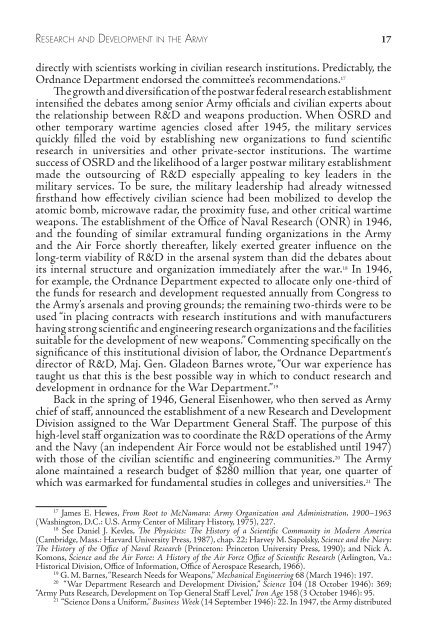To download as a PDF click here - US Army Center Of Military History
To download as a PDF click here - US Army Center Of Military History
To download as a PDF click here - US Army Center Of Military History
Create successful ePaper yourself
Turn your PDF publications into a flip-book with our unique Google optimized e-Paper software.
ReseaRch a n d developmenT In T h e aR m y 17<br />
directly with scientists working in civilian research institutions. Predictably, the<br />
Ordnance Department endorsed the committee’s recommendations. 17<br />
The growth and diversification of the postwar federal research establishment<br />
intensified the debates among senior <strong>Army</strong> officials and civilian experts about<br />
the relationship between R&D and weapons production. When OSRD and<br />
other temporary wartime agencies closed after 1945, the military services<br />
quickly filled the void by establishing new organizations to fund scientific<br />
research in universities and other private-sector institutions. The wartime<br />
success of OSRD and the likelihood of a larger postwar military establishment<br />
made the outsourcing of R&D especially appealing to key leaders in the<br />
military services. <strong>To</strong> be sure, the military leadership had already witnessed<br />
firsthand how effectively civilian science had been mobilized to develop the<br />
atomic bomb, microwave radar, the proximity fuse, and other critical wartime<br />
weapons. The establishment of the <strong>Of</strong>fice of Naval Research (ONR) in 1946,<br />
and the founding of similar extramural funding organizations in the <strong>Army</strong><br />
and the Air Force shortly t<strong>here</strong>after, likely exerted greater influence on the<br />
long-term viability of R&D in the arsenal system than did the debates about<br />
its internal structure and organization immediately after the war. 18 In 1946,<br />
for example, the Ordnance Department expected to allocate only one-third of<br />
the funds for research and development requested annually from Congress to<br />
the <strong>Army</strong>’s arsenals and proving grounds; the remaining two-thirds were to be<br />
used “in placing contracts with research institutions and with manufacturers<br />
having strong scientific and engineering research organizations and the facilities<br />
suitable for the development of new weapons.” Commenting specifically on the<br />
significance of this institutional division of labor, the Ordnance Department’s<br />
director of R&D, Maj. Gen. Gladeon Barnes wrote, “Our war experience h<strong>as</strong><br />
taught us that this is the best possible way in which to conduct research and<br />
development in ordnance for the War Department.” 19<br />
Back in the spring of 1946, General Eisenhower, who then served <strong>as</strong> <strong>Army</strong><br />
chief of staff, announced the establishment of a new Research and Development<br />
Division <strong>as</strong>signed to the War Department General Staff. The purpose of this<br />
high-level staff organization w<strong>as</strong> to coordinate the R&D operations of the <strong>Army</strong><br />
and the Navy (an independent Air Force would not be established until 1947)<br />
with those of the civilian scientific and engineering communities. 20 The <strong>Army</strong><br />
alone maintained a research budget of $280 million that year, one quarter of<br />
which w<strong>as</strong> earmarked for fundamental studies in colleges and universities. 21 The<br />
17 James E. Hewes, From Root to McNamara: <strong>Army</strong> Organization and Administration, 1900–1963<br />
(W<strong>as</strong>hington, D.C.: U.S. <strong>Army</strong> <strong>Center</strong> of <strong>Military</strong> <strong>History</strong>, 1975), 227.<br />
18 See Daniel J. Kevles, The Physicists: The <strong>History</strong> of a Scientific Community in Modern America<br />
(Cambridge, M<strong>as</strong>s.: Harvard University Press, 1987), chap. 22; Harvey M. Sapolsky, Science and the Navy:<br />
The <strong>History</strong> of the <strong>Of</strong>fice of Naval Research (Princeton: Princeton University Press, 1990); and Nick A.<br />
Komons, Science and the Air Force: A <strong>History</strong> of the Air Force <strong>Of</strong>fice of Scientific Research (Arlington, Va.:<br />
Historical Division, <strong>Of</strong>fice of Information, <strong>Of</strong>fice of Aerospace Research, 1966).<br />
19 G. M. Barnes, “Research Needs for Weapons,” Mechanical Engineering 68 (March 1946): 197.<br />
20 “War Department Research and Development Division,” Science 104 (18 October 1946): 369;<br />
“<strong>Army</strong> Puts Research, Development on <strong>To</strong>p General Staff Level,” Iron Age 158 (3 October 1946): 95.<br />
21 “Science Dons a Uniform,” Business Week (14 September 1946): 22. In 1947, the <strong>Army</strong> distributed

















